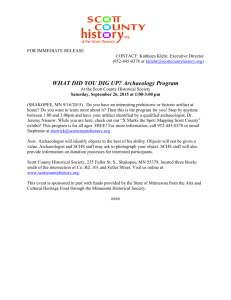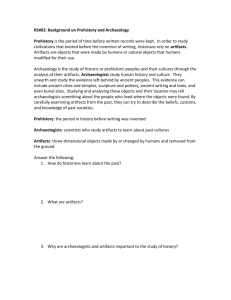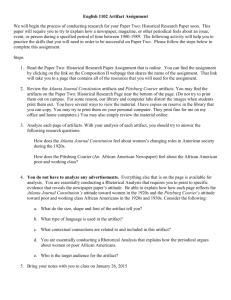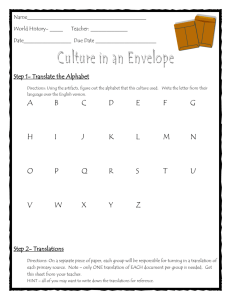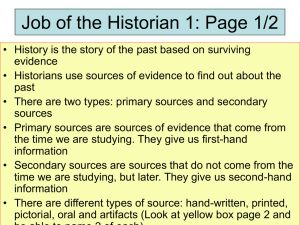Danielle O`Rourke Professor Larken 20 minute lesson plan October
advertisement
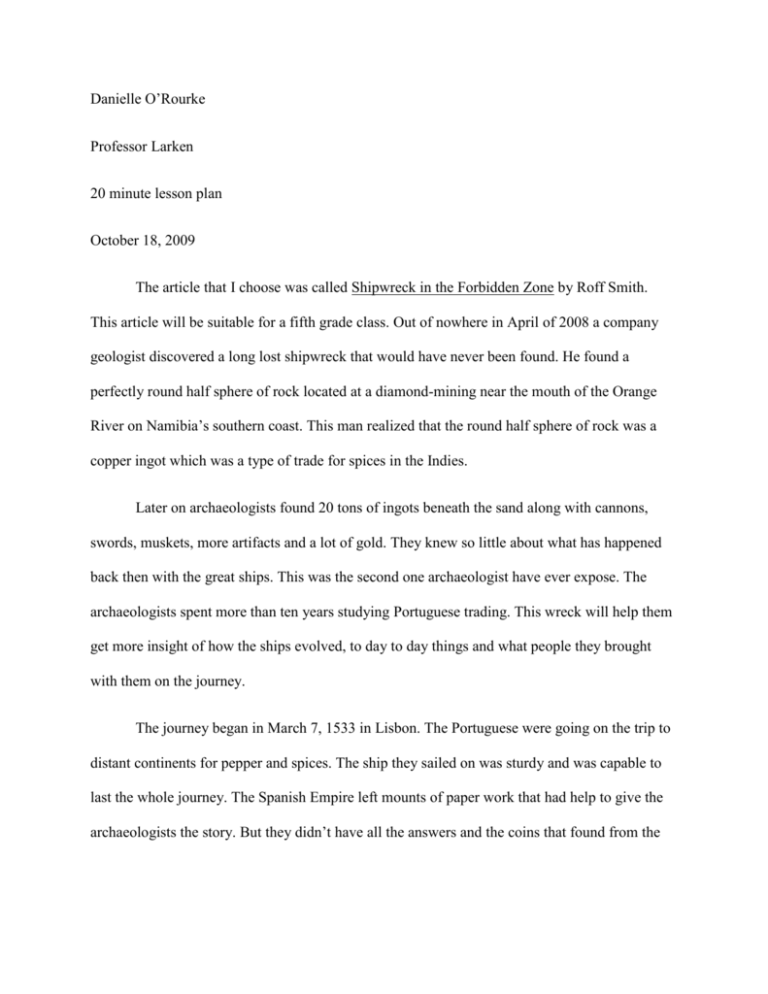
Danielle O’Rourke Professor Larken 20 minute lesson plan October 18, 2009 The article that I choose was called Shipwreck in the Forbidden Zone by Roff Smith. This article will be suitable for a fifth grade class. Out of nowhere in April of 2008 a company geologist discovered a long lost shipwreck that would have never been found. He found a perfectly round half sphere of rock located at a diamond-mining near the mouth of the Orange River on Namibia’s southern coast. This man realized that the round half sphere of rock was a copper ingot which was a type of trade for spices in the Indies. Later on archaeologists found 20 tons of ingots beneath the sand along with cannons, swords, muskets, more artifacts and a lot of gold. They knew so little about what has happened back then with the great ships. This was the second one archaeologist have ever expose. The archaeologists spent more than ten years studying Portuguese trading. This wreck will help them get more insight of how the ships evolved, to day to day things and what people they brought with them on the journey. The journey began in March 7, 1533 in Lisbon. The Portuguese were going on the trip to distant continents for pepper and spices. The ship they sailed on was sturdy and was capable to last the whole journey. The Spanish Empire left mounts of paper work that had help to give the archaeologists the story. But they didn’t have all the answers and the coins that found from the ship help fill in the missing pieces. The gold on the ship came from King Joao on February 13, 1533 picked up 20,000 crusadoes’ worth of gold. If it hadn’t been for the copper ingots weighing everything down there would be no trace of anything. The reason the ship sunk was because of a huge winter storm the wind was over 80 miles an hour. There was absolutely no way that anyone could survive this horrible wreck. The only trace of body parts that were found were human toes in shoes. They wasn’t any hope for help because the waves were so intense. The rivers have washed away millions of diamonds down as far as 1,700 miles inland. This would be an easy read for the students. It’s not that difficult to understand the concept of artifacts that are found. This is a great way for the students to get a better understanding of what an artifact is and who are the people that discover the artifacts. Activity 1: Before my students leave on Friday I will ask everyone to go home and research what an artifact is. I will also give them a hand out with vocabulary words from the article that I don’t think that they would know. I would ask the students to also bring in a piece of gold jewelry so that I can show them how the archaeologists clean the gold that was found. On the hand out it will have 10 words which are: 1. Geologist2. Archaeologist3. Excavated4. Archaeological5. Manuscripts6. Copper Ingot- 7. Consortium8. Rigged9. Exquisite10. CurrentActivity 2: I will go over the answers for the homework that I gave them for Friday. I would bring in pictures and describe what an artifact looks like. I would also bring in sea shells and leaves and describe how these two things are artifacts as well. Will have them watch a Bill Nye the Science guy video about archeology. Then I would have the students get into groups of 4 and have them read the article called Shipwreck in the Forbidden Zone. I would have them read aloud to each other and then have them work on a question work sheet that will consist of 10 questions. The 10 questions are: 1. Where was the ship found? (p.119) 2. The archaeologist later found a staggering 22 tons of _________ beneath the sand? (p.120) 3. What was the name of the archaeology program that spent for the ten years studying Portuguese trading vessels? (p.121) 4. When did the long forgotten voyage begin?(p.121) 5. What was the name of the two brand-new sturdy ships that was owned by the king himself? (p.122) 6. How many ships were lost on their way to India between 1525 and 1600? (p.123) 7. What occurred on the date of February 13, 1533? (p.123) 8. If it wasn’t for_________ weighing everything down, there would be nothing left here to find” says Bruno Werz (p. 126) 9. What made the ship sink? (p.126) 10. What is there a millions and billions of down from deposits as far as 1,700 miles inland? (p.127) Activity 3: For the students to get a feel of what an archaeologist does. I will split the children up into 4 groups and bring in brown bags for each group filled with trail mix. I will also need a plastic bag, artifact analysis form, and plastic bag form. Then I would explain to the children that they need to understand that an archaeologist records everything that is found and that is what the artifact analysis form is for. When they pick out of the brown bag just say that got a raison they would take the raison and put that in one of the plastic bags. If next they pick out a nut then they have to put the nut in a different plastic bag. I would have the students recording how many of each different product in the trail mix and record it on the analysis form. This will help the students understand the job of an archaeologist. Activity 4: For a reminder at the end of the week, I will have everyone bring in a picture of an artifact or if they can find an actual artifact bring it into class. On construction paper have the students write the artifact on top, then have them write why it is an artifact and then have them draw the artifact. I will then hang their drawings in the classroom. Time Allotted in Minutes Objectives Activity Friday 60 min. For the student to understand the vocabulary words before we begin the reading. I will ask the students if they have any idea what an artifact is. If they don’t I will make sure that by the end of the day they will have an understanding of the word. Then I will discuss the Monday 60 min. The students will understand what an artifact is and how gold is cleaned. Tuesday-Friday 20 min. Have the student understand what an archaeologist does. They will understand how an archaeologist correlates with artifacts. vocabulary words. After we go over the vocabulary I will give out a hand out to review the vocabulary. They will be allowed to partner up and help each other with the definitions. I will bring in pictures, shells and leaves to help show my students what an artifact is. I will have the students watch a Bill Nye the Science guy video. Then I will hand out the article and have them read it with in groups of 4. Then in their groups they answer the questions that I will provide for them. When they are finished answering the questions. I will ask the students to raise their hands if they knew the answer to the questions and we will go over them. I will have my student do an activity showing how an archaeologist works. Then I will have the students bring in artifacts and on construction paper write what the artifact is, why it’s an artifact and draw a picture of it. Then hang their work around the classroom.

